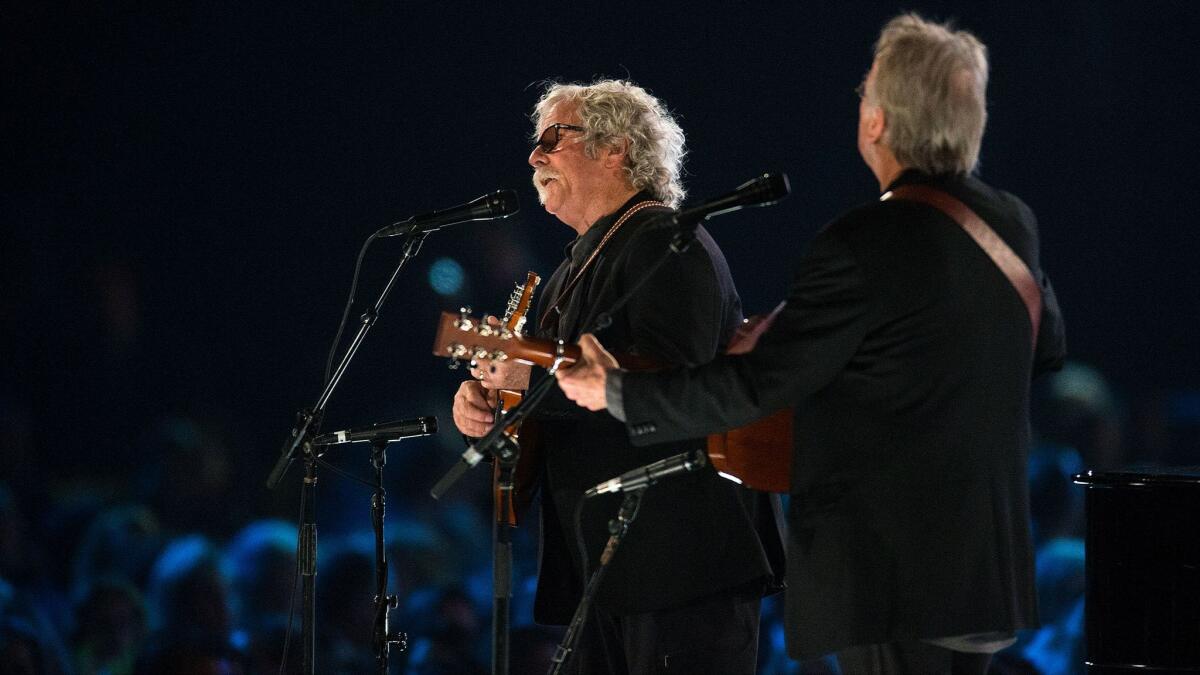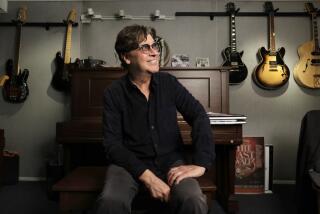Byrds co-founder Chris Hillman taps David Crosby, Roger McGuinn, Tom Petty for new solo album

Chris Hillman, a founding member of the Byrds and the Flying Burrito Brothers, is releasing a new album, “Bidin’ My Time.” Here, recounts the story of how Stephen Stills gave him a 1924 Gibson Lloyd Loar F5 mandolin as a ‘thank you’ gesture in 1972.
Byrds co-founder and ace musician Chris Hillman is on the verge of releasing “Bidin’ My Time,” a new album he’s recorded with Tom Petty co-producing, but at his home office and study in Ventura this August, the artist is in a reflective mood.
He reaches down toward a phalanx of instrument cases lining one wall of the building in which he conducts much of his business these days.
He snags one of the smaller ones, unzips the protective cloth cover, unsnaps the hard-shell case underneath and removes a gorgeous Lloyd Loar F5 model Gibson mandolin that looks as if it came out of the factory yesterday. It’s 93 years old.
“Stephen Stills gave this to me,” Hillman, 72, says softly. “He’d invited me to Florida to play on some sessions, and one day he said, ‘You know that mandolin you’ve been playing onstage? It’s really bad.’”
Hillman said he knew. The sound, he confessed, was poor. Stills said, “‘Here, try this one,’ and handed me this one. I played a little on it and I said, ‘Man, this is beautiful.’ He said, ‘It’s yours.’”
Hillman, who recently had considered himself more or less retired from the recording studio before putting together “Bidin’ My Time,” pauses, seemingly taken back to the early ’70s. With Stills, Hillman would form the band Manassas, one of several historically significant acts Hillman has on his resume. Hillman,with Roger McGuinn, David Crosby, Gene Clark and Michael Clarke would launch the Byrds in 1964 and help kick-start the genre of folk rock.
“I said, ‘You can’t give this to me’,” Hillman said as he continued the tale of the mandolin. “Stephen said, ‘You got us our first job at the Whisky a Go-Go — it’s yours’,” referring to the equally influential rock-country-folk band Buffalo Springfield.
Hillman demurs. “Hey, I was just a bass player and I told Elmer [Valentine, the Whisky’s founder] there was this new band he ought to hire.”
In many ways this is the story of Hillman’s life: As a creative artist and musical collaborator, he’s often quietly ceded the spotlight to peers. who’ve been happy to soak up more public attention and adoration.
“At the start, nobody really knew who he was when he was in the Byrds, what was really there,” David Crosby, 76, said of his longtime friend with whom he is reunited on “Bidin’ My Time,” due Sept. 22.
“At the beginning he was just standing there playing bass,” Crosby recalled. “But as soon as he started writing and singing, people figured out, ‘Oh, I get it.’ Then when he did his own band, the Desert Rose Band [in the 1980s and ’90s] it was plain he was excelling as a singer and a songwriter. He was the whole package, and it was fun to watch people discover him.”

Crosby reconnected with Hillman recently on a new rendition of the Byrds’ standard “The Bells of Rhymney,” which opens the new album that is produced by two friends of long-standing: Byrds acolyte Petty, and bluegrass country singer and instrumentalist Herb Pedersen.
McGuinn also adds his voice to Hillman’s again on “Here She Comes Again,” a song Hillman wrote in 1978 for the short-lived McGuinn, Clark & Hillman trio long after they’d last sung together in the Byrds.
“What I always liked about that song is that it captured the Beatles/Byrds ’65 feel,” Hillman said, “and it did that without a fluff lyric.”
Pedersen said he floated the idea to Petty of working together on a new Hillman album last fall, when Petty brought Pedersen along as an additional voice for a tour by Mudcrutch, the band Petty had in Florida before coming to California and assembling the Heartbreakers.
.
“I didn’t go looking for this,” Hillman said of the overall project.
“I was more or less retired. We spend most of our time now chasing thieves,” he said, referring to tracking down copyright infringement issues with the help of his wife, semi-retired music publicist Connie Pappas Hillman.
Yet “Bidin’ My Time” contains nods to virtually every phase of Hillman’s musical life, with acoustic bluegrass, jangly folk-rock and sweet country-rock that lend a full-circle quality to the project, which concludes with Hillman’s version of Petty’s song “Wildflowers.”
Hillman updated his song “Old John Robertson,” from the 1968 album “The Notorious Byrd Brothers,” adding a contemporary spin and a new title to create “The New Old John Robertson.” He and Pedersen also sing the Everly Brothers’ 1961 pop hit “Walk Right Back” — a track that was a happy accident.
“We were between songs in the studio and Herb and I were just singing it for fun,” he said. “Tom came running out of the booth and said, ‘Let’s cut that right now!’”
When the idea of Petty and Pedersen co-producing a new album was presented to Hillman, his response was self-deprecatingly humble.
“I asked Tom, ‘Are you sure you want to do this?’ And then he asked me, ‘Do you want me to do it?’” Hillman said, chuckling. “We went back and forth like that a couple of times. At one point I told him, ‘You haven’t even heard any of my [new] songs.’ And he said ‘I’m not worried about that.’”
Pedersen promised to score Hillman a new recording contract — “Right!” he scoffed initially — but he made good on his word, connecting Hillman with the long-running folk and roots label Rounder Records, now part of the Concord Music Group, which also is the parent company to Sugar Hill Records, the folk and bluegrass label for which Hillman recorded in the late ’90s and early 2000s.
“We jumped at the chance to be part of this record,” said Gary Paczosa, Rounder’s vice president of artists and repertoire and a 10-time Grammy Award-winning producer. “He’s an amazing musician, writer and singer — Chris has it all.
“There wasn’t any music played for us, which is usually what you start with,” before the label committed to the project, Paczosa said. “But from the beginning, we knew with the involvement of Tom and Herb producing this record, we knew we were going to get a well thought-out, well cared-for record.”
The new collection makes a couple of nods to the band in which he shot to national fame, including another Byrds update, this one also featuring McGuinn in a contemporary rendition of Clark’s “She Don’t Care About Time,” a non-album track that originally was released as the B side of the 1965 “Turn! Turn! Turn!” single.
“When David and I were in the studio, I asked him if he remembered while the Byrds were on tour ever seeing Gene reading a book,” Hillman said. “He said he couldn’t. Neither could I. Maybe he had a great English lit teacher in school or something, but he would write these beautifully poetic lyrics that we would all aspire to, and I don’t know where it came from.”
When the Byrds came together in L.A. in 1965, McGuinn and Crosby were, at about 23 and 24, the senior members. They were a couple of years older than Hillman and Clark, while drummer Clarke was the baby of the group, barely 19.
Each had been involved in other folk groups, and McGuinn had also worked as a session musician in New York, then going by his first name, Jim, before switching to his middle name, Roger, as the Byrds took flight.
Crosby, of course, made the jump to Crosby, Stills & Nash (and soon, Young), while McGuinn and Clark launched solo careers.
Meanwhile, Hillman’s post-Byrds path could support a pop music family tree of its own.
He left the Byrds to form the greatly influential country-rock group the Flying Burrito Brothers with latter-day Byrds member Gram Parsons — another beneficiary of Hillman’s ear for promising talent. It was Hillman who persuaded Parsons to check out a young singer Hillman had heard in a club in Washington, D.C., which led to Parsons’ introduction to future country great Emmylou Harris.
The ’70s were also when Hillman teamed up with Stills in Manassas, before moving on with singer-songwriter J.D. Souther and Buffalo Springfield alumnus Richie Furay to launch the short-lived Souther-Hillman-Furay Band. He then reconnected in the late-’70s with two former Byrds to create McGuinn, Clark & Hillman, another conglomeration that sounded more like a law firm than a rock group.
The ’80s brought another career rejuvenation for Hillman when he formed the Desert Rose Band, a group that included his old friend and early band mate Herb Pedersen along with steel guitar great Jay Dee Maness and multi-instrumentalist John Jorgenson.
The Desert Rose Band came along during what Steve Earle likes to call “the Great Credibility Scare of the late-’80s,” when a number of progressive country acts (before the term “Americana” came into fashion) were regularly visiting the country charts.
Country radio eventually shifted its attention to superstar acts like Garth Brooks, Faith Hill and Tim McGraw, and Hillman and Pedersen continued touring and recording as a duo, returning to an earthier folk-bluegrass sound.
It’s a mini-Desert Rose Band reunion that Hillman is taking out on tour to help promote the new album. He, Pedersen and Jorgenson will be stopping on Oct. 16 at the Troubadour in West Hollywood, the epicenter of the L.A. folk scene in the ’60s that Hillman describes as “the place where it all began for us.”
More than a half-century later, rather than retiring, with “Bidin’ My Time” Hillman is basking in one more chance to make music with people he’s known and respected for most of his life.
“I’m very happy with it,” he said. “Am I chasing a career? No. Am I going to get on the charts? No. If you continue doing this, first you have to determine if you’re still a semblance of what you were in your prime. And second, you need to know if people are still interested in hearing you.”
See the most-read stories in Entertainment this hour »
Follow @RandyLewis2 on Twitter.com
For Classic Rock coverage, join us on Facebook
More to Read
The biggest entertainment stories
Get our big stories about Hollywood, film, television, music, arts, culture and more right in your inbox as soon as they publish.
You may occasionally receive promotional content from the Los Angeles Times.










